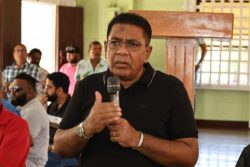By Tarron Khemraj
Introduction
Budget 2010 was named “Consolidate, Transform and Sustain.” I was happy to see the term “transform” given prominence on the cover page of budget document. The Minister of Finance was not clear on the meaning of transform. However, these Development Watch columns have termed transformation to be modernizing the production structure of the economy. In particular, renewable energy, manufacturing, agro-processing and service industries would lead the modernization.
 Production transformation is very important as the well-being of citizens is dependent on it. This importance was emphasized by the United Nations Conference on Trade and Development (UNCTAD), which did the 2006 Least Developed Countries Report on “building productive capacities.” According to UNCTAD, the transformation of production capacities is important not only because it is the only way to eradicate poverty in the long term, but also because they lead to the creation of jobs. It is also the only method to create a robust economy that is removed from “welfare colonialism” to borrow the term of economist Erik Reinert (recently Reinert wrote a beautiful book: How Rich Countries got Rich…and why Poor Countries Stay Poor).
Production transformation is very important as the well-being of citizens is dependent on it. This importance was emphasized by the United Nations Conference on Trade and Development (UNCTAD), which did the 2006 Least Developed Countries Report on “building productive capacities.” According to UNCTAD, the transformation of production capacities is important not only because it is the only way to eradicate poverty in the long term, but also because they lead to the creation of jobs. It is also the only method to create a robust economy that is removed from “welfare colonialism” to borrow the term of economist Erik Reinert (recently Reinert wrote a beautiful book: How Rich Countries got Rich…and why Poor Countries Stay Poor).
In Guyana’s case welfare colonialism manifests itself as perpetual dependence on IMF/WB for policy advice, never-ending dependence on foreign aid and remittances. I have argued several times in these columns that given that we are 18 years post October 1992 this welfare colonialism should be on the wane. Instead it is assuming new forms and new alliances with places with different world powers. It is not so clear what economic rationale and strategy are driving the new form of alliances for welfare colonialism. Anyone who would like to see a quantification of the new focus of foreign policy, examine page 70 of the budget statement. It spells out in dollar terms the radical change in source of bilateral loans. The public will see that Guyana has now entered into new dependent relationships. The problem with this new foreign policy thrust (of welfare colonialism) is that one of the countries claims 5/8 of Guyana’s land.
Positives?
The economy has remained relatively stable over the year 2009. Inflation is relatively low, the fiscal deficit narrowed significantly, Bank of Guyana (BoG) accumulated unprecedented foreign exchange reserves and the exchange rate is stable. GDP grew at a moderate 2.3%.
However, we need to understand that growth premised on resource extraction and a housing programme will not be sustainable. Readers by now would realize that these columns prefer to link production capacities with a policy to build infrastructure or houses. I am of the view that this can be done simultaneously. Therefore, it would have been better if the government provided data to show inter-industry production linkages. Example, what percentage of locally made toilet fittings is used in new homes? What about locally made pre-fabricated cupboards, doors, windows, etc? The point I am making is the way to build domestic production capacity – a large part of which was destroyed by the trade and financial liberalization agenda of the ERP – is to have policies that encourage this development. Merely outlining a sum of new funds for housing development is not enough for an economy faced with serious coordination and market failures.
National statistics
The budget speech noted that the government will rebase GDP and update the basket used to measure the CPI (which gives inflation). This is a welcome development. However, if the Ministry of Finance really wants to show progress they need to show us how the economy is transforming. The latter would require that we have data on inter-industry vertical and forward linkages. In addition, we need the mystery surrounding the unemployment rate to stop. Guyana needs regular labour market surveys. Also, it would be helpful if the government also provide us with regular data on the labour force participation rate.
The balance of payments
On the surface the outturn on the BOP seems strong (see p.69 of budget speech). After all Guyana has accumulated all time high foreign exchange reserves in 2010. The capital account registered a surplus, which was enough to record an overall surplus on the BOP. However, I would not say this outturn is a signal of a robust economy. Rather the capital account surplus is the result of new disbursements of loans (US$135.2 million) and other assistances. Debt relief amounted to US$184.9 million.
Transfers (a large part of which is remittances) have also played an important role in the current account (amounting to US$299.6 million), which recorded a deficit in spite of the gold export boom. The trade balance turned out to be a deficit of US$401 million. Many would agree a trade balance surplus is a very good way to signal a robust economy and perhaps a transforming one. Some of the good luck of 2010 may not be sustainable and one can expect gold price to start falling when the US economy fully recovers, the fiscal deficit is narrowed, and the Federal Reserve drains the US banking system of excess reserves.
An interesting outcome on the capital account is private capital inflows. It is not clear what percentage of the US$208 million is foreign direct investment. Also the budget statement noted portfolio investments, which means investments in financial assets. Into which portfolio of Guyanese financial assets these inflows were invested? Given the structure of the financial system this would likely be bank deposits.
Are foreigners banking in Guyana? It would be nice if the government clarifies this since we know portfolio flows are hot money flows and are the most debilitating when they rush out suddenly.
The budget’s focus on
structural transformation
Structural change, according to the budget, is based on the LCDS. It is not so clear however what role the LCDS will play in a post-Copenhagen world and with vociferous opposition to the climate change agenda in places like United States and Australia. Guyanese should be aware that the LCDS essentially has two sides.
(i) The financing side is based on compensation for not cutting down our forests. (ii) The policy proposals for infrastructure and alternative industries. Number (ii) is dependent on receiving approximately US$580 million per year. If one should strip away the financing side one is left with a set of ideas that go back to the National Development Strategy, which itself did not explain how to finance the policy proposals.
The budget gives two main policies for real transformation. (i) Pursue hydroelectricity and (ii) Information and Communication Technology (ICT). I am very sympathetic to the ICT policies and the vigour with which the budget targets this new sector. The budget also emphasizes training for ICT. The long-term productivity gains from the government’s ICT push would be enormous. However, there is potentially one spanner in the wheel works. If the government envisages Guyanese businesses one day doing business process outsourcing (BPO), which country is more likely to purchase these services? China? Russia? Iran? United States? Perhaps President Jagdeo could venture an answer.
I am less sympathetic to the idea of one large hydroelectric power plant. Given current demand for power and the geographically dispersed population, the unit cost (and thus price) of electricity will be very high if one large hydro is built. In my opinion, a better strategy would be to have several geographically concentrated hydroelectric plants tied to industrial activities. In addition, a more holistic renewable energy strategy should be implemented focusing on hydroelectricity, ethanol, bio-diesel, expanded co-generation (from sugar cane waste and coconut shells/husks) and wind energy.
The latter sectors not only create new energy sources, but also simultaneously engender permanent manufacturing industries and jobs. Are we to wait until the single large hydro is completed to start thinking about creating production capacity?
Conclusion
As usual the budget exercise outlines the sources of revenue (taxes, etc) and proposed government expenditures. The expenditure designations are diverse. However, from a perspective of structural production transformation, we see two important policies. (i) ICT and (ii) nascent moves towards one large hydroelectric power plant (which will not be realized for many years).
While I am sceptical about the prospects of a single hydro, ICT demonstrates the government’s willingness to bend comparative advantage – the kind of policies that are necessary. However, while it is important to bend comparative advantage, sometimes a prudent look at current capabilities will reveal potential for industrial development without waiting about eight years for the realization of the silver bullet hydro.
For instance, industrial policies can link housing development to businesses supplying materials for housing. Also, the sugar infrastructure provides an opportunity for a national ethanol agenda. Coconut farming can be revitalized by national bio-diesel policy. In addition, coconuts provide the foundations upon which numerous other industrial applications can be based.




